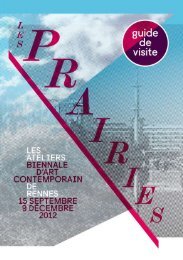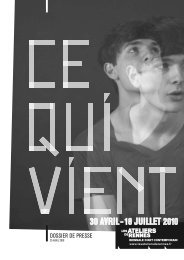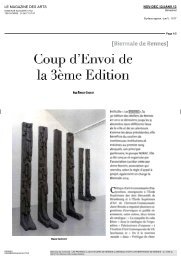Download here the Visitor's guide. - Les Ateliers de Rennes
Download here the Visitor's guide. - Les Ateliers de Rennes
Download here the Visitor's guide. - Les Ateliers de Rennes
Create successful ePaper yourself
Turn your PDF publications into a flip-book with our unique Google optimized e-Paper software.
78<br />
<strong>Les</strong> Prairies's artists<br />
Gare SNCF, parvis sud<br />
LOIS WEINBERGER,<br />
Gar<strong>de</strong>n, 1994-2012.<br />
Production<br />
<strong>Les</strong> <strong>Ateliers</strong> <strong>de</strong> <strong>Rennes</strong> 2012.<br />
Since <strong>the</strong> beginning of <strong>the</strong> 1970s Lois Weinberger has been<br />
militant in <strong>the</strong> cause of spontaneous vegetation. He is an<br />
opponent of voluntaristic cultivated plots and weeding,<br />
and <strong>the</strong> i<strong>de</strong>as of purity and purification that go with <strong>the</strong>m.<br />
Weinberger is <strong>the</strong> advocate of weeds, <strong>the</strong> fringe and <strong>the</strong><br />
interstices. His preoccupations, in fact, are more political<br />
than botanical. Through <strong>the</strong> dynamics of indigenous and<br />
non-indigenous species he raises <strong>the</strong> question of conflict<br />
between native populations and immigrants and <strong>the</strong><br />
contingent problems of i<strong>de</strong>ntity and migration. Processes of<br />
hybridization, colonization and interference occur and lead<br />
to a progressive blurring of <strong>the</strong> distinction between «wild»<br />
and «cultivated». In Weinberger’s work it is always <strong>the</strong> hardy,<br />
invasive, self-propagating plant that prevails.<br />
Gar<strong>de</strong>n occupies an interstice of <strong>the</strong> city of <strong>Rennes</strong>. The<br />
sou<strong>the</strong>rn forecourt of <strong>the</strong> station, which is bor<strong>de</strong>red by<br />
railway lines, a prison and waste ground, presents a usefully<br />
imprecise area on which to place two thousand yellow plastic<br />
buckets full of earth and spontaneous vegetation. «I don’t<br />
plant anything and I don’t sow anything. I leave <strong>the</strong> soil<br />
open to whatever comes, w<strong>here</strong>ver it comes from – <strong>the</strong> wind,<br />
animals, even <strong>the</strong> earth itself», says Weinberger a great<br />
believer in «letting things happen».<br />
Revived for Prairies, 3rd edition of <strong>Les</strong> <strong>Ateliers</strong> <strong>de</strong> <strong>Rennes</strong><br />
2012 – biennial for contemporary art (September 15th-<br />
December 9th 2012), this ephemeral and changing work of art<br />
will remain settled until <strong>the</strong> end of <strong>the</strong> biennial. It has been<br />
realized with <strong>the</strong> cooperation of Ville <strong>de</strong> <strong>Rennes</strong>.<br />
Lois Weinberger<br />
Born in 1947 in Stams, lives and works in Vienna (Austria).<br />
Gar<strong>de</strong>n, 2002. installation view, Lower Austria<br />
Museum, St Pölten.<br />
Courtesy of <strong>the</strong> artist.<br />
“Plastic buckets are arranged on a concrete surface, filled<br />
with soil from open land. Since t<strong>here</strong> are seeds in <strong>the</strong> soil /<br />
<strong>the</strong> work will <strong>de</strong>velop on its own. Spontaneous vegetation.<br />
With time, all that remains of <strong>the</strong> pots will be fragments of<br />
/ colorless plastic on <strong>the</strong> overgrown areas. These, too, will<br />
ultimately dissolve, and <strong>the</strong> blossoms alone will recall <strong>the</strong>ir<br />
initial color. Later, my work will hardly be noticed / <strong>the</strong><br />
creator has disappeared.“<br />
L.W., Vienna, 1994.






